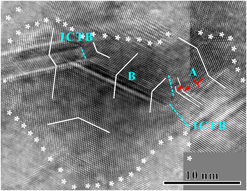Crossref Citations
This article has been cited by the following publications. This list is generated based on data provided by
Crossref.
Zheng, Si-Xue
Luo, Xue-Mei
Wang, Dong
and
Zhang, Guang-Ping
2018.
A novel evaluation strategy for fatigue reliability of flexible nanoscale films.
Materials Research Express,
Vol. 5,
Issue. 3,
p.
035012.
Sun, Bin
Huang, Xingzhen
and
Li, Zhaoxia
2020.
Electro-mechanical Degradation Model of Flexible Metal Films Due to Fatigue Damage Accumulation.
Metals and Materials International,
Vol. 26,
Issue. 4,
p.
501.
Yang, Yu-Jia
Zhang, Bin
Wan, Hong-Yuan
and
Zhang, Guang-Ping
2020.
Role of Cu/graphene interface in suppressing fatigue damage of submicron Cu films for flexible electronics.
Materials Science and Engineering: A,
Vol. 792,
Issue. ,
p.
139786.
Wu, Xu-Ping
Luo, Xue-Mei
Chen, Hong-Lei
Zou, Ji-Peng
and
Zhang, Guang-Ping
2020.
A unified model for determining fracture strain of metal films on flexible substrates.
Journal of Materials Science & Technology,
Vol. 54,
Issue. ,
p.
87.
Sun, Bin
Huang, Xingzhen
and
Xu, Zhaodong
2021.
A damage evolution rate controlled method for catastrophic failure process of metal films.
Mechanics of Materials,
Vol. 160,
Issue. ,
p.
103929.
Chen, Hong-Lei
Luo, Xue-Mei
Wang, Dong
Schaaf, Peter
and
Zhang, Guang-Ping
2021.
Achieving very high cycle fatigue performance of Au thin films for flexible electronic applications.
Journal of Materials Science & Technology,
Vol. 89,
Issue. ,
p.
107.
Zheng, Yichuan
Huang, Xingzhen
and
Li, Zhaoxia
2022.
Numerical simulation of fatigue behavior of flexible metal films in multiphysics fields.
Fatigue & Fracture of Engineering Materials & Structures,
Vol. 45,
Issue. 11,
p.
3237.
Li, C Z
Xu, Z T
Peng, L F
and
Lai, X M
2022.
Investigation on thickness size effect on ductility of magnetron sputtered Niobium coatings on SS316L substrate for forming of precoated metallic bipolar plates.
IOP Conference Series: Materials Science and Engineering,
Vol. 1270,
Issue. 1,
p.
012111.
Chalklen, Thomas
Smith, Michael
and
Kar-Narayan, Sohini
2023.
Improved fatigue resistance in transfer-printed flexible circuits embedded in polymer substrates with low melting temperatures.
Flexible and Printed Electronics,
Vol. 8,
Issue. 2,
p.
025014.
Sittkus, Benjamin
Petit, Julien
Urban, Gerald
and
Mescheder, Ulrich
2024.
Crack preserving effect in ultrathin metal films on elastomer membranes induced by e-beam irradiation.
p.
1.
Chen, Honglei
Luo, Xuemei
Zhang, Mingyuan
Wen, Ming
Zhu, Xiaofei
and
Zhang, Guangping
2024.
More severe surface relief but stronger fatigue resistance at small scales: Vacancy-assisted fatigue damage mechanism.
Acta Materialia,
Vol. 274,
Issue. ,
p.
120028.
Jung, Dongwuk
and
Ju, Hunpyo
2024.
Strategy for Enhancing Functional Density of Stretchable Electronics by Self-Sensing Interconnects.
JOURNAL OF SENSOR SCIENCE AND TECHNOLOGY,
Vol. 33,
Issue. 5,
p.
344.
